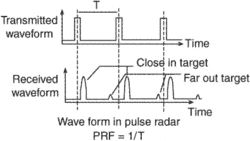Real-time spectrum analyzers are essential for anyone dealing with signals that vary dynamically in amplitude or are agile in frequency:
pulsed radar systems, frequency-hopping spread spectrum radios, and pulse modulated radios; multi-signal environments: ISM bands - 915 MHz, 2.4, 5.8; or unwanted signals such as unintentional or self-interference, intentional interference (jammers), and listening devices (bugs).
For the latter, the target range is determined from the propagation time of the
pulsed radar returns from the target.
Unlike with
pulsed radar systems, communication systems such as the U-NII devices have high transmit duty cycles that preclude filtering by single-pulse interference filters like the one implemented in the TDWR (Cho 2011).
The self-calibrating tool uses
pulsed radar technology to detect a variety of concealed objects in concrete at depths up to 5-7/8 inches: ferrous and non-ferrous, wood or plastic and electrical conduits.
A
pulsed radar system transmits short bursts or pulse signals instead of continuous-wave (CW) signals.
Pulsed radar locates targets by transmitting a microwave pulse beam that reflects off precip and back to the radar receiver as a return often called an echo.
Radar cross-section measurements were taken using QinetiQ's multi-band
pulsed radar system, with results showing significant reductions.
At trials, prototype 44m stealth blades were fitted on to a Vestas V90 turbine and radar cross section (RCS) measurements were taken using the Qinetiq multiband
pulsed radar system.

